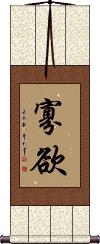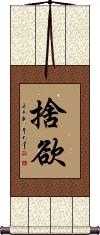Many custom options...
And formats...

Not what you want?
Try other similar-meaning words, fewer words, or just one word.
Feel free to email me with your request. If it's easy, I'll translate it for free and add it to this database of calligraphy for you.
Release of Desires in Chinese / Japanese...
Buy a Release of Desires calligraphy wall scroll here!
Personalize your custom “Release of Desires” project by clicking the button next to your favorite “Release of Desires” title below...
Release of Desires
Give Up Desire
Not the results for release of desires that you were looking for?
Below are some entries from our dictionary that may match your release of desires search...
| Characters If shown, 2nd row is Simp. Chinese |
Pronunciation Romanization |
Simple Dictionary Definition |
頭陀 头陀 see styles |
tóu tuó tou2 tuo2 t`ou t`o tou to zuda ずだ |
itinerant monk (loanword from Sanskrit) (1) {Buddh} ascetic practices; ridding oneself of desires for food, clothing and shelter; (2) {Buddh} religious medicancy; mendicant monk; (3) (abbreviation) (See 頭陀袋) sack; carry-all bag dhūta, also 杜多; 杜荼 shaken, shaken off, cleansed. To get rid of the trials of life; discipline to remove them and attain nirvāṇa. There are twelve relating to release from ties to clothing, food, and dwelling: (1) garments of cast-off rags; (2) only the three garments; (3) eat only food begged; (4) only breakfast and the noon meal; (5) no food between them; (6) limited amount; (7) dwelling as a hermit; (8) among tombs; (9) under a tree; (10) under the open sky; (11) anywhere; (12) sitting and not lying down. There are other groups. |
The following table may be helpful for those studying Chinese or Japanese...
| Title | Characters | Romaji (Romanized Japanese) | Various forms of Romanized Chinese | |
| Release of Desires | 寡欲 | keyoku | guǎ yù / gua3 yu4 / gua yu / guayu | kua yü / kuayü |
| Give Up Desire | 捨欲 舍欲 | shayoku | shě yù / she3 yu4 / she yu / sheyu | she yü / sheyü |
| In some entries above you will see that characters have different versions above and below a line. In these cases, the characters above the line are Traditional Chinese, while the ones below are Simplified Chinese. | ||||
Successful Chinese Character and Japanese Kanji calligraphy searches within the last few hours...





